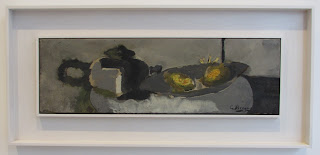"What greatly attracted me - and it was the main line of advance of Cubism - was how to give material expression to this new space of which I had an inkling. So I began to paint chiefly still lifes, because in nature there is a tactile, I would almost say a manual space... that was the earliest Cubist painting - the quest for space." - Georges Braque.
With this being the first solo exhibition of Georges Braques's work in London for nearly 25 years I felt I had to make the effort to see it. The exhibition consisted of a series of Braque's still life paintings, many featuring the dark, muddy palette of browns and greys so redolent of paintings of the early and mid-twentieth century. Several display flashes of colour, mercifully enlivening the gloomy hues of these paintings which belie Braque's early, but brief association with the Fauve movement. Braque's main preoccupation with his art would become the depiction of space and perspective within the picture plane which of course led to the radical, groundbreaking development of Cubism in conjunction with Pablo Picasso. In his Cubist paintings Braque combined different views of his subject matter within the same canvas, which broke the traditional formal rules of European perspective. This resulted in paintings that appeared fragmented and abstracted, in which the illusion of space, and the flatness of the canvas were emphasised. Braque continued to explore spatial relationships in his artworks long after the end of Cubism. The results of these investigations can be seen in this enchanting exhibition at Bernard Jacobson with a series of domestic sized still life paintings in which Braque investigates the constant arrangements of objects, fruits and the spatial planes on which they sit.



















No comments:
Post a Comment